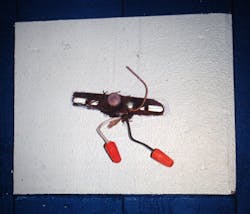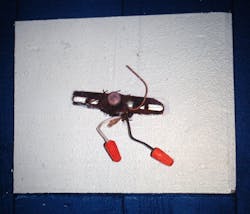What’s Wrong Here? Hint: It's What You Don't See
How well do you know the Code? Think you can spot violations the original installer either ignored or couldn't identify? Here's your chance to moonlight as an electrical inspector and second-guess someone else's work from the safety of your living room or office. It's your turn to identify the violation.
Hint: It's what you don't see.
Find the Answer
No box! That's the problem here. This is what I found when I removed a luminaire to be replaced. The fixture bar was screwed directly to the wood siding of the house with an NM cable feeding the luminaire. The domed luminaire canopy was being used to cover the splices against the wood siding.
Section 300.15 requires when the wiring method is conduit, tubing, AC cable, MC cable, MI cable, nonmetallic-sheathed cable, or other cables, a box or conduit body shall be installed at each conductor splice point, outlet point, switch point, junction point, termination point, or pull point,unless otherwise permitted in 300.15(A) through (L). Part (A) tells us a box or conduit body shall not be required for each splice, junction, switch, pull, termination, or outlet points in wiring methods with removable covers, such as wireways, multioutlet assemblies, auxiliary gutters, and surface raceways. Part (B) permits an integral junction box or wiring compartment as part of approved equipment in lieu of a box. However, this does not include luminaire canopy covers installed against the wood siding. If the splices or wires started arcing, this could ignite the combustible wood, since there was no box to contain the arcing or sparks.
> Try Another Quiz
About the Author

Russ LeBlanc
Owner
Russ started in the electrical trade as an apprentice in 1985. He worked his way up to become a Journeyman Electrician and then eventually became a Master Electrician and Licensed Construction Supervisor. In 1999 Russ become an Electrical Instructor for The Peterson School of Engineering in Massachusetts where he developed his passion for teaching, and quickly became Department Head of Electrical Instruction. Russ has taught thousands of apprentices, electricians, engineers, inspectors, and other electrical professionals during his career as an instructor. He continues to provide electrical professionals with Electrical Code seminars, Arc-Flash Awareness training seminars and educational material through his LeBlanc Consulting Services in North Reading, MA whose specialty is educating electricians. He has been an active member of the NFPA Electrical Section and has authored hundreds of National Electrical Code proposals and comments which have become Code rules to improve the safety for the electrical industry. Russ is also an IAEI certified Electrical Inspector.
Please visit www.russleblanc.net for more information.

